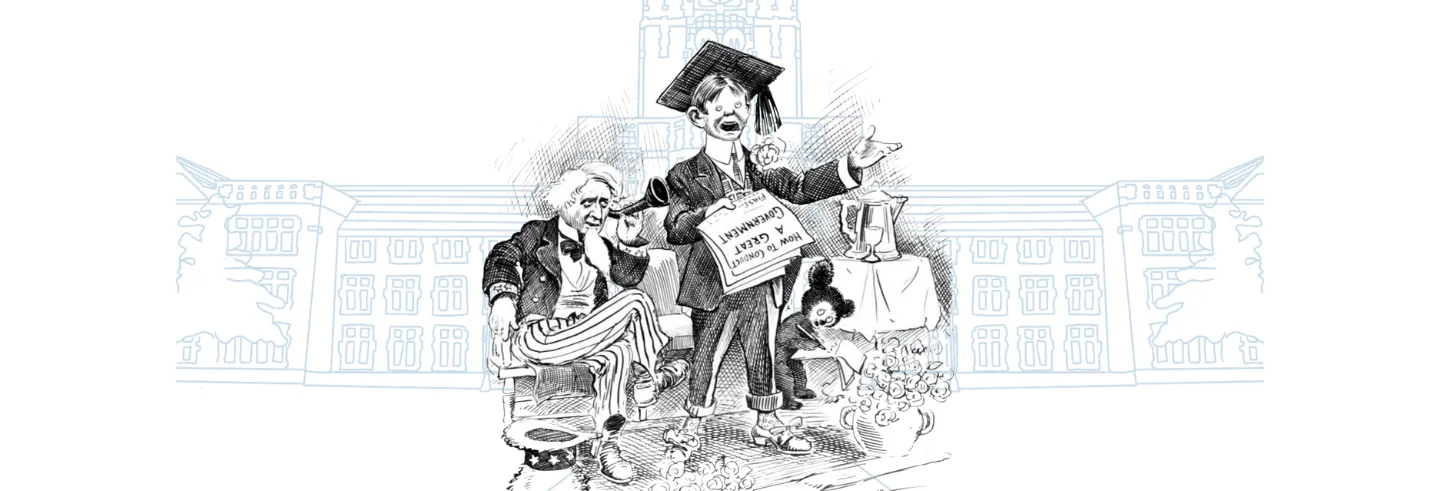The recent conflict between President Donald Trump’s administration and Harvard University has caught the attention of the world. This is not surprising because elite universities in the United States have an unprecedented global reach. It is difficult to think of a historical parallel to the position of US universities in our time. They influence knowledge, ideas, and intellectual discourse.
Elite American universities are possibly the most important mechanism of US soft power, being the preferred means of education for the political and intellectual elite around the world. Indians are now the largest group of international students in the US (NBC News 2024). It is no surprise then that the conflict over US universities has received much attention in India. Ramchandra Guha (2025) argues that “Trump’s attack on US universities is a tragedy for the entire world”, that these universities are an “adornment to humanity”, and that Trump’s actions make him feel a “deep sense of anguish and anger”. His argument is not unusual in that it perhaps captures the spirit of the dominant response among Indian intellectuals, particularly those who have spent time in American universities.
A study published last year found that the alumni of 34 universities dominated lists of “extraordinary achievers across politics, the military, business, science, academia, and the arts”.
Quite contrary to the nostalgia and anguish of the global intelligentsia, the American public has declining confidence in higher education. According to a recent Gallup Poll (2024), close to 70% of Americans believe that higher education is going in the wrong direction. Further, the number of Americans who have confidence in higher education has declined to 36% from 57% over the past 10 years.
What explains this decline in confidence and pessimistic expectations about the future?
The crisis of confidence in higher education mirrors the crisis of legitimacy in the American state apparatus itself. According to the latest polls (Navigator Research 2024), close to three quarters of the American population believes that the American political and economic system needs major changes, with 12% believing that it needs to be torn down completely. Trust in most major institutions, including the courts, media and government, is very low.
This crisis takes a specific form in the elite universities being attacked by Trump. These universities are the primary preparatory grounds for the ruling elite. A study published last year (Wai et al. 2024) found that the alumni of 34 universities dominated lists of “extraordinary achievers across politics, the military, business, science, academia, and the arts”. Harvard alone accounts for almost 16%. The percentage of Americans who go to Harvard is, of course, minuscule in comparison.
Elite universities are the centre of ideological production but are no longer able to control discourse and the interpretation of events. The ideological consensus in America, which these universities shaped, has broken down. The elites they prepared and their worldview are no longer trusted by the public.
It is worthwhile to see the historical trajectory of the universities themselves to understand the roots of this crisis.
Cold War
In many ways, the Cold War period that followed World War II is essential to understanding the nature of the modern American university. In 1958, the National Defense Education Act provided an increased amount of federal funding to research to compete with the Soviets in science and technology. Universities were refashioned into powerful research institutions and saw an increase in doctorates awarded, which jumped to around 34,000 by 1973 from less than 2,000 at the end of the war (National Science Foundation 2006). The number of doctorates awarded in non-science fields and engineering reached near peak levels in 1973, and has remained stagnant or even declined since then.
Close to 80% of the federal research and development budget in the 1950s came from the Department of Defense. Research was tied to defence priorities.
As David Brooks (2024) argues in an essay in the Atlantic, along with the increased funding, college administrators began to open up admissions in the universities to a wider section of society, beyond those who were “good-looking, athletic, graceful, casually elegant, Episcopalian, and white”.
There were two consequences of this rapid growth in colleges. First, university budgets were deeply tied to the developing US war economy. Close to 80% of the federal research and development budget in the 1950s came from the Department of Defense. Research was tied to defence priorities. This was especially so in the sciences and engineering, but it was valid across all fields. Many of the area studies departments, for example, were formed in this era through defence-related funding as part of American intelligence efforts (Schrecker 2021).
Scholar and activist W.E.B. Du Bois put it best in his description of American higher education in 1952. “We still have large college and university facilities, but the entering students are poorly equipped and with limited ideals and objectives. The professors are today increasingly afraid to study and teach the social sciences, so that history becomes propaganda; economics hides in higher mathematics and social study is limited by military objectives. In the physical sciences our objects have become limited mainly to weapons of war.”
The other major feature of the rapid expansion was the atmosphere of McCarthyism (Schrecker 1986). Faculty was required to take loyalty oaths. Academics turned against each other and accusations of association with the Communist Party were enough to lose one’s job and career. Many academics chose to comply with McCarthyism. This anti-communism severely limited the ideological spectrum across disciplines.
Black Freedom Struggle
Defence spending and anti-communism led to a close relationship between the university and the American state, severely curtailing the democratic possibilities in mainstream universities that came with an expanded student population and professoriate.
This democratisation of the university was to come from elsewhere. A parallel system of education, the Historically Black Colleges and Universities (HBCUs) was seeing a very different kind of movement at this time. Many of the presidents and teachers of HBCUs, like Benjamin Mays and William Stuart Nelson, were intimately involved in shaping the ideas behind the Black Freedom Struggle (also known as the Civil Rights Movement).
The courage and determination of the students during the Black Freedom Struggle cannot be overemphasised. They participated in sit-ins and desegregation campaigns.
The HBCUs were essential in establishing connections with the Indian freedom struggle and exploring the relevance of the ideas of ahimsa and satyagraha in the American context. Martin Luther King Jr. was educated at an HBCU (Morehouse College; 1944–1948) as was Du Bois (Fisk University; 1885–1888). Du Bois later went to Harvard, and he said, “I did not find better teachers at Harvard, but teachers better known” (Du Bois 1944).
The HBCUs became the centre of a powerful student movement whose impact is not appreciated enough. It was while Diane Nash was at Fisk University (1959–1961) in Nashville, Tennessee that she first heard of the non-violence workshops being conducted by James Lawson, a civil rights leader who had spent time in India. She participated in these workshops and was eventually converted to the philosophy of non-violence. She went on to provide leadership of the Nashville student movement.
The courage and determination of the students during the Black Freedom Struggle cannot be overemphasised. They participated in sit-ins and desegregation campaigns. When the Freedom Riders, participants in the campaign to desegregate interstate buses, were interrupted and attacked by a white mob in 1961, it was Nash and the Nashville students who continued with the rides despite a serious risk to their lives (Dong 2020).
When the Student Nonviolent Coordinating Committee was formed in 1960, many Black students dropped out of university to join in. This first generation of student activism allied itself with the Black Freedom Struggle led by Dr. King and hence served as a model for student activism.
The Black Freedom Struggle’s call for a transformation of American society radicalised a generation of academics in US universities. It led to the large-scale student protests of the late 1960s, with demands to form Black Studies departments and end the war against Vietnam. The activism was more pronounced at HCBUs and public universities but all universities were affected.
The Black Panther Party, for example, had a following on several campuses and one of the points in the programme was explicitly on education. “We want education for our people that exposes the true nature of this decadent American society. We want education that teaches us our true history and our role in the present-day society” (Black Panther Party 1966).
Public universities were defunded [after the 1970s] and education shifted either to vocationalism or to an elite discourse away from the democratisation of knowledge.
There were calls to more closely integrate education at the university with the surrounding community and to teach socially relevant courses. Several scientists opposed military funding and the collaboration of universities. Black leaders often spoke at major universities. There were new democratic possibilities for American universities at this time.
“The crisis on American campuses has no parallel in the history of the nation”, the Presidential Commission on Campus Unrest reported in 1970. The focus of the unrest was on “three major questions: racial injustice, war, and the university itself”. The third of these, according to the report, was that “Students complain that their studies are irrelevant to the social problems that concern them”.
Rather than responding to these concerns, the American ruling elite responded by mounting a counter-revolution as reflected, for example, in The Powell Memorandum (Powell 1971). Public universities were defunded and education shifted either to vocationalism or to an elite discourse away from the democratisation of knowledge. Professional administrators were hired to run universities in the style of corporations and the role of faculty in administration declined (Ginsberg 2011). Federal and state laws were passed to deal with campus disorders.
Professional Managerial Class
The Jewish American immigrant experience is particularly relevant to understanding the counter-revolution in American universities. Early Jewish immigrants, particularly from Central and Eastern Europe, often with working-class backgrounds, were inclined towards left-wing politics. Many of them were kept out of Ivy League universities and studied in New York, where they became part of the Trotskyite left. Others joined the Communist Party and the Black Freedom Struggle. The experience of the Holocaust and recognition of the Soviet Union’s role in the defeat of Hitler had played a role in radicalising many immigrant Jews.
The Jewish immigrant, however, had a path to assimilating into the structure of American white supremacy. The Jew in America, said James Baldwin in 1967, had “become an American white man”. In due course, Jewish Americans were not only fully accepted in elite American universities but also started totally dominating them. On one account, “Some 25% of the Harvard student body was Jewish from the 1960s onward. Yale was perhaps as much as one-third Jewish in the ’70s and ’80s. The University of Pennsylvania was always mythologised as being 40% or even a half Jewish, though the best numbers indicate the high-water mark was more in the 35% range” (Rosen 2023).
The ideas that intellectuals had a responsibility to society, should join in a mass struggle, or contribute to a scientific understanding of society were scoffed upon.
However, many of the erstwhile Trotskyites and so-called New York Intellectuals (Wald 1987) who had started on the left ended up founding the extremely right-wing ideological movement called neo-conservatism (Lobe 2016). This movement advocates that America should be in a permanent state of war to spread “democracy” worldwide and holds the position that America and, eventually, Israel are special states not accountable to international law.
The neo-conservatives and their intellectual allies strongly opposed the student movement. Sidney Hook had responded to the student movement by starting the University Centers for Rational Alternatives, which called any appeasement of the student movement “morally intolerable and practically disastrous”. Jewish intellectuals contributed to the intellectual counter-revolution against the democratic demands of the student movement.
State repression and intellectual counter-revolution was not just confined to the academy but felt in society as a whole. However, the academy in particular was not able to stand up against this repression and instead aligned itself with the state.
If one section of the left turned to the right, the other turned towards identity politics. A group of French intellectuals, whose ideas were associated with post-modernism, became heroes of humanities departments. The ideas that intellectuals had a responsibility to society, should join in a mass struggle, or contribute to a scientific understanding of society were scoffed upon. Eventually, words like “trauma”, “privilege”, and issues of individual gender and sexuality began dominating activism on campus. Richard Rorty (1998) correctly foresaw some of the consequences of the rise of this cultural left, which abandoned working people in favour of correcting discourse in the academy.
While the humanities moved towards elite discourse, the sciences totally moved away from truth and philosophy towards application and incremental advance. These applications, more often than not, were driven by profits and war. As Jeff Schmidt argued in his book Disciplined Minds (2000), even basic research in physics was, sometimes imperceptibly but very concretely, shaped by funding agencies. Professors continued to argue that they were pursuing their interests, even as the sum total of these interests became extremely narrow and specialised under constraints of funding and publishing.
Elite universities transformed into sites of careerism and esoteric discourse disconnected from society. The consequent multiculturalism and wokeness was not only acceptable, but was promoted by the ruling elite.
[In the cities] the universities try to create idealised gentrified neighbourhoods with coffee-shops, bookstores, and galleries for white and international youth, pushing out longtime Black residents...
All of this happened alongside the declining fortunes of working class America. The story of how working people in America have suffered over the past 50 years from deindustrialisation and globalisation is now well known.
As urban centres deindustrialised, and universities became more and more profit driven, many cities became dominated by the “knowledge economy”. Universities have now become large employers, gentrifiers, and tax exempt property owners in cities (Klug 2025). To take an example, the University of Pennsylvania is the largest employer in Philadelphia (CWIA 2024). Universities often have large medical schools with close ties to the pharmaceutical industry. They have large private police forces. The University of Chicago Police Force is one of the largest private police forces in the world (Baptiste 2015).
The stark contrast between the university and the American people is particularly visible in cities like Philadelphia and Chicago that have large Black populations. There is a language of anti-racism within the universities, which has little or nothing to do with the lives of Black working people. The universities try to create idealised gentrified neighbourhoods with coffee-shops, bookstores, and galleries for white and international youth, pushing out longtime Black residents who continue to live in the presence of poverty and violence.
The new role of universities has created a class of people sometimes termed the “Professional Managerial Class” (Tait 2024), a managerial, professional and educated elite whose role in society is to justify and reproduce the dominant institutions. Their struggle with working people has been called the new class war (Lind 2020) shaping Western democracies and has made universities the site of intense social struggle in American society.
Lessons for Today
As Gideon Rachman (2025) argues, Trump’s attack on Harvard has nothing to do with anti-semitism even if this is given as an official reason. Zionism has been institutionalised in American universities for a long time, as was evidenced by their response to the courageous students who protested against the genocide in Palestine. The fight against the universities may be framed as a cultural battle, as some intellectuals do, but it is in reality part of a much larger ongoing social struggle in American society.
…[W]e should question if permanent war and profits are the only possible drivers of research and innovation. What, in other words, is the purpose of education and its relationship to society?
Higher education is a primary signifier of the social divide in America and the professional managerial class has become central to the Democratic Party (Cohn 2024). Trump is aware that universities have become deeply unpopular among the American working class whose support is crucial to his transformation of the Republican Party.
What are the lessons to be learnt? First, we should understand that the conflict over universities is indicative of the deep social and ideological conflicts taking place in American society.
Second, we should be critical of the American university model. Universities have become islands of wealth and esoteric discourse in a sea of poverty and struggle. We must be cognisant of the deep relationship of the American university to the American state and defence establishment. The area studies departments that Trump is threatening to dismantle have been previously criticised as extensions of the US state department. Such isolated institutions, which promote careerism and individualism at the cost of socially relevant education, are not models for the rest of the world. However, many of the new private universities in India are trying to take after them.
Finally, nobody will deny that research and innovation are important and that universities play a large role in promoting it. However, we should question if permanent war and profits are the only possible drivers of research and innovation. What, in other words, is the purpose of education and its relationship to society? The fate of the American universities offers a lesson on the fate of rootless institutions that are rejected by the public.
Archishman Raju is a scientist based in Bengaluru, who is associated with the Gandhi Global Family and Intercivilizational Dialogue Project.









